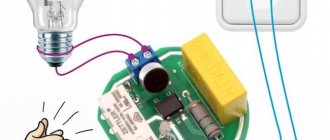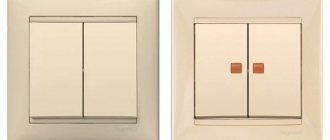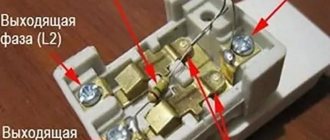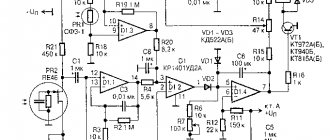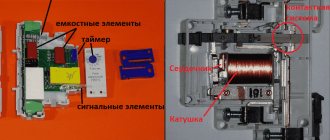The sound sensor is used not only for alarms, detection devices, but also as a base for smart lighting. An acoustic automatic switch can be included in a lighting fixture, but is often sold separately. The controller can be mounted on any line with a light bulb, on other electrical devices, adding to them the function of remote switching on by sound. Modern noise sensors can distinguish a certain range of sound commands (1 or 2 claps, etc.) with different responses to them.
Application
The light switch claps on and off in response to the noise it makes. The operating algorithm is as follows: the first clap is switching on, the second is switching off.
It is recommended to install devices of this type only in quiet rooms. Premises of this type include bedrooms, storage rooms, utility rooms, and basements. It is irrational to install cotton devices in rooms where there are many people (offices, living rooms, industrial areas), since extraneous noise leads to false reactions of the devices.
The most common place to install a slam light switch is in the bedroom. It is very convenient to control the lighting without getting out of bed. Cotton systems are popular in families with small children, since to turn the light on or off you no longer need to reach for a high-mounted switch.
Many people confuse cotton and acoustic devices. The acoustic switch is triggered by any noise, and the clap switch is triggered only by claps.
Prospects
These devices are constantly evolving. It is likely that models that accept voice commands will soon appear. Previously, the cost of such production was too high.
Check it out here too!
Low and high pass filter: making frequency filters and how to create high-end circuitry (95 photos + video)Do-it-yourself electric bike: how to build an inexpensive and powerful electric bike from scratch (100 photos)
How to choose a gas boiler - the best models and manufacturers. Review of modern boilers and options for their application (145 photos and videos)
However, recently software has come a long way in identifying voice commands. This will allow you to create blocks at an acceptable cost. You just need to say a command from the list of programmed ones.
A voice-controlled unit can control several sensors at once, sending commands to their destination. With the help of such devices it will be possible to turn on a variety of devices, not just lights.
Types of sound switches
Acoustic switches can respond to voice commands and claps
The following types of acoustic switches exist:
- Devices that react to cotton. It is programmed in advance at what number of claps a particular command will be executed.
- Devices that respond to voice or a preset command.
- Combined devices (for example, light-acoustic switch). They can be equipped with sound, light or motion sensors. These are the most technologically advanced devices in which the risk of false alarms is minimized.
- Devices for low-current systems. Used to connect a video camera or transmit a command to security.
Acoustic switches have become popular due to their ease of use. They are useful for the elderly, bedridden patients and young children. Devices of this class are already actively used in the Smart Home system.
Clap switch with microcontroller
A microcontroller is a small piece of silicon covered in plastic and has metal terminals that does not perform any functions without software. Its use in any appliance makes it smart and involves use in the Smart Home system.
Difference from standard sound switch:
- reduced response time to 100 microseconds;
- possibility of reprogramming, setting individual parameters;
- increased range;
- the ability to change the signal threshold value (to eliminate interference and avoid responding to false commands);
- smooth change in lighting brightness;
- fewer components;
- short circuit protection.
Dimmer acoustic switch
Optical-acoustic switch for hidden wiring
Dimming is the regulation of the load that the device consumes. Using dimmers, you can smoothly turn on the light, adjust the brightness of an LED lamp or incandescent light bulb. Not suitable for fluorescent lamps. Dimmer devices can also be used to regulate the temperature in irons, soldering irons, kettles and other household appliances.
An optical-acoustic switch is needed for dimmer switching on electricity. The operating principle of the microcircuit is as follows:
- the signal in the form of sound reaches the microphone;
- sound is converted into impulse;
- the pulse is sent to the microcontroller and passes through the amplifier, charging the capacitor;
- a large charge is achieved, after which the comparator switches;
- the zero at the output changes to a pulse;
- the transit generator is activated, which sends impulses;
- the triac opens, through which power passes to the lamp;
- the capacitor loses voltage level;
- a signal with increasing phase retardation is supplied to the triac;
- The light turns on smoothly.
If you select all component values correctly, the lamp turns off with a pause of up to 3 minutes. To operate the dimmer, you need a lamp with a power of at least 40 W. The voltage on the optical-acoustic switch varies smoothly in the range from 0 to 220 V.
Advantages:
- Thanks to smooth switching on, the lamp service life increases;
- the ability to create lighting of the required brightness in a certain place;
- the ability to control light using intelligent systems.
Disadvantages include the inability to open the network in the event of a short circuit and the lack of a protective function against overloads.
Dimmers are not recommended for radios, televisions and products with switching power supply, as they cause interference.
Acoustic auto switches and relays, what are they?
Detectors that respond to sound signals, with a relay that opens/closes power circuits, have long been known as parts of security and alarm systems. Over time, they became popular for lighting systems, lamps of any kind, for apartments, entrances, on the streets, in courtyards. There are no restrictions on use. You can buy a sound controller for light in almost every electrical store.
A sound sensor for lighting is a small box with electronic elements and a microcircuit inside. Usually this is a plastic rectangle with exposed contacts, terminals for connection and holes for fastening with bolts. The product can also be made as a lampshade or have any other form at the discretion of the manufacturer. There is also a modular design: lighting fixtures, light bulbs or sockets for them, inside of which such detectors with a release are mounted.
Advantages:
- If we compare motion and noise sensors, the main advantage of the latter is the absence of false alarms during the movement of pets and electromagnetic interference;
- low price, on average 300 rubles;
- Possibility of installation in any conditions, the device is extremely compact;
- additional options: programmability for different commands, sensitivity adjustment, analysis of the presence of light and its level, so as not to turn on during daylight hours.
There is, perhaps, only one downside: false alarms due to background noise. The problem can be solved by adjusting the microphone sensitivity, but not all products have this function.
Noise detectors for lighting are used for hard-to-reach places where it is impossible to reach the manual switch:
- entrances;
- corridors;
- bathrooms;
- warehouses;
- Technical buildings;
- street lighting;
- staircases;
- local areas;
- This is a great solution when you have a small child who is afraid of the dark, as he won't have to look for the switch.
Typically, acoustic sensors are always used together with manual switches: the presence of such devices, no matter how many there are on the line, does not in any way affect their operation.
Principle of operation
The device operates using a microcontroller installed in it. The controller authorizes turning the light on and off by clapping. If desired, this device can be used to control other electrical household devices (air conditioners, fans, etc.).
A typical audible light switch contains an electronic microphone with a preamplifier. This component amplifies the sound entering the device, which allows you to record even the quietest pops. The operation of the amplifier is controlled using transistors VT1 and VT2. The circuit is controlled by a pair of resistors R2, and diodes VD1 and VD2 are used to equalize the signal.
The sound from the clap passes through the microphone, where the electrical impulse is amplified and transformed. Next, the sound is equalized due to the work of rectifying diodes. The sound is controlled by a resistor (if the sound volume level is below the specified level, the resistor will prevent the device from operating). When the signal on the capacitor is leveled, the voltage increases and the transistor switch VT3 opens.
The light turns off and on after sequential charging and discharging of the capacitors. At the end of a full cycle of activity (one more bang), the resistor and capacitor C10 are discharged in four seconds. This causes the device to turn off.
What to choose
For passage rooms, such as common corridors of buildings and staircases of apartment buildings, as well as for storerooms and similar rooms, the simplest noise sound sensor is suitable. In most cases, there is no point in installing more advanced models there. It is advisable that the delay be adjusted.
Inside the living quarters of the rooms in the bathrooms, sensors are used that distinguish commands and adjust the sensitivity of the microphone. The last option is recommended for all types of such controllers, the same applies to the activation function only in the dark. For example, an excellent choice would be a product that distinguishes commands installed in the hallway-corridor of an apartment: when a person enters, the light will turn off with one clap, two claps when the door is closed, it will turn off.
If there is significant background noise (entrance facing a noisy street), sound sensors with adjustable microphone sensitivity should be installed. If the characteristics of the environment require it, for example, when noise is undesirable during certain periods, then combined models with acoustic and motion sensors are chosen at the same time; such devices are practical, since one of the options can be turned off when not needed.
How it works
The simplest cotton switch has an electronic microphone in its circuit; in addition, an amplifier is installed with it in the form of two transistors connected to each other. These small details amplify any sound entering the microphone several times. Thanks to this, the switch can be activated even with a slight clap.
The amplified sound pulse is supplied to a powerful transistor, a relay coil is connected to its collector, the power circuit of which is connected to the lighting network. That is, the transistor controls this relay, and it, in turn, closes or opens the contacts in the lamp power circuit.
A capacitor is installed in the microphone circuit. You can select its capacity and thereby adjust the sensitivity of the microphone to the supplied sound.
simple acoustic switch circuit
The acoustic switch is designed on the same principle. The scheme works as follows. The sound captured by the microphone is converted into an electrical signal (voltage). The amplification cascade amplifies the voltage, in this form it is supplied to a powerful transistor, and from it to the relay coil. Current begins to flow through the relay, the magnetic core is retracted, thereby closing the power contacts of the relay in the lighting circuit. The light comes on.
Particularly experienced and competent electricians and radio amateurs will be able to assemble such a circuit on their own.
Automatic soft switch
The switch serves to smoothly turn on the light from an analog microphone signal for a specified time.
Scheme of operation of a smooth acoustic switch
The sound enters the microphone, is converted into an electrical signal and amplified, passing through the operational amplifier (DA1.1), charging the capacitor (C6). When the charge becomes greater than the capacitance (C7), the comparator (DA1.2) switches, and a logical one signal appears at its output instead of zero. As a result, the generator on the transistor (VT1) starts, it supplies pulses that open the triac (VS1), through which power is supplied to the lamp (EL1).
After a certain time, the voltage across the capacitor will decrease. As it decreases, the triac receives control pulses with an increasing phase delay, causing the lamp to turn off smoothly.
Having selected the ratings (C6) and (R5), you can turn on the lamp for up to 3 minutes.
Specifications
As an example, let’s look at the characteristics of a standard device for turning the light on and off by clapping.
Device data:
- Power is supplied from a standard network with a voltage of 220 Volts.
- The maximum total power of consumers does not exceed 300 Watts.
- Sound control ranges from 30 to 150 decibels.
- Permissible temperature range: from 20 degrees below zero to 40 degrees above zero.
- Housing protection class - IP30.
A variety of lamps are used in the network:
- Incandescent and halogen light sources.
- Energy-saving or fluorescent light bulbs.
- LED devices.
The specified characteristics comply with the requirements of the law of the Russian Federation number 261. This act regulates the rules for the rational use of electrical energy.
The equipment is similar in size to a matchbox, that is, compact. This makes it possible to install it close to the lamps. The device is fixed using self-tapping screws or double-sided tape.
Connection errors
The main problem during installation is always not taking into account the power of consumers. For most touch-sensitive light switches, the maximum throughput load is limited to 1 kW. In no case should it be exceeded. Most devices of this type do not contain safety elements that block excessive load. Hence their relative fire hazard when the maximum is exceeded.
Another relatively common mistake when installing 220V touch-sensitive light or energy switches is the incorrect connection of the contact groups. For example, it has been noticed more than once that they try to separate the zero of the power supply network with a control device, instead of a phase. Of course, this creates significant problems in its functioning; it becomes simply impossible.
The practical connection of a phase and a COM port for end devices does not make much sense. However, its purpose is different - to communicate with other switches or pass-through switches.
Acoustic switch circuit
There are a huge variety of acoustic switch (AS) circuits: on transistors, logic chips, flip-flops, etc., but we will assemble our device on a microcontroller. Using a microcontroller, you can quite simply implement algorithms of varying complexity with minimal circuit modification or no modification at all.
The first and integral element of any acoustic switch is a microphone. The microphone converts the audio frequency signal into alternating voltage. The simplest electret microphone will suit us.
One terminal of the microphone is connected to the negative, and the second, through a trimming resistor R1, with a resistance of 510 kOhm, to the positive. Using R1, you adjust the microphone sensitivity. Next, the alternating signal from the microphone output through a 1 µF capacitor C1 is fed to an amplifier made on a single BC547 transistor. The emitter of the transistor is connected to the minus, and the collector is connected to the plus through resistor R2, with a resistance of 1 kOhm. The amplifier is adjusted using a tuning resistor R3 with a resistance of 1 MOhm.
Next, the amplified signal is fed to the input of the ATmega8 microcontroller. Depending on the number of received pulses, which corresponds to the number of claps, the microcontroller outputs a high or low potential to the corresponding pins. In this circuit, we use three pins of the MK microcontroller, which operate as output. They feed three similar circuits. Let's consider the operation of one circuit.
When there is a high potential (+5 V) at the MK output, transistor VT2 of the 2N2222 series, connected to the MK by resistor R4 (1 kOhm), opens and relay coil K1 receives power. When relay K1 is triggered, its contacts close in the lamp power circuit and thus it lights up.
The relay coil K1 should be shunted with a reverse diode VD1 to protect against overvoltage, since the coil has some inductance, and if the circuit breaks, a voltage surge may occur, although not significant in this case, but it is better to be safe. Almost any diode with a current of at least 100 mA will do; you can use 1N4148.
Any relay can be used, but you should focus on the following parameters: supply voltage 5 V, voltage of the closing contacts - alternating, 230 V. The contact current is determined by the load of the circuit that the contacts will close and open. I used the following type of relay: HW32-005VDC-A. If you find a relay with a coil supply current of no more than 20 mA, then you can do without a transistor switch.
The acoustic switch circuit is powered from a stabilized power source with a voltage of 5 V. You can take any ready-made power supply or assemble it yourself, as described in this article.
Features of self-production
What do you need to make an acoustic switch? You will need to prepare resistors, transistors, diodes, capacitors, relays, microphone and terminal box. A detailed list of parts can be found on the Internet by visiting specialized sites.
The first step in the instructions on how to make an acoustic sensor is usually the manufacture of a printed circuit board. Once it's ready, drill the holes and don't forget to trim it.
Then, focusing on the selected circuit, solder all the parts to their corresponding places. Work on the switch is completed.
Another electrical diagram
There are many options on the Internet of varying complexity depending on the configuration, but not all of them are functional. Defects appear during manufacturing. The presented electrical circuit has been tested in practice.
Here VD1 is intended to protect transistor VT3. To use a relay, a diode must be installed . If you decide to install a light load, we recommend replacing the diode with a jumper.
Socket device with switch
There are units on sale in which power and lighting switches are combined. Structurally, they do not differ from separate devices, except that they have 1 common contact for the phase.
Advantages
The combined electric point has a number of advantages:
- Simple connection diagram, because both devices are powered by 1 line.
- Wire saving.
- The need to knock out 1 hole in the wall instead of 2 and with large dimensions, which makes the process easier.
Flaws
The negative sides are:
- High cost: individual electrical installation products are cheaper than a combined device.
- The need to change the entire device if one of the modules breaks down.
- Limited choice of installation location: such products are used in corridors or technical rooms - garages, etc.
- Increased load on the wire.
The installation of a socket with a switch is very expensive.
Connection diagram and installation
Below is a diagram of a clap light switch. Based on it, you can connect this device.
The white conductors available on the device are connected to the network. The load is connected to the black wires. To connect copper conductors, you will need terminals. The black conductors are connected to the lamp bulb. These devices are connected in parallel.
The switch is powered via a single-key switch. If you need to turn it off, you just need to press the switch.
The sound sensitivity is controlled by the corresponding regulator. It is recommended to use the average audio value.
Hidden and outdoor installation methods
The very first thing you have to decide is what type of switch is needed, which can be indoor or outdoor.
In the first case, installation is carried out inside the wall, for which holes of the appropriate size are cut in it. This type of device is used most often, since the wiring is mainly laid in a hidden way.
External switches are used either in wooden houses, in which the wiring is most often done in an open type, or when lighting devices are laid according to a temporary scheme - in this case, in order not to cut the walls, the wires are laid on their surface.
How to connect?
The cotton switch “Ekosvet-X-300-L” in question consists of a block in which the entire circuit is mounted, and two pairs of wires - white and black. The white ones need to be connected to a 220 V electrical network, the black wires are connected to the lighting load.
The lamp receives zero (directly) and phase (through an ordinary household switch) from the distribution box. These two wires are connected to the white wires. You can do this using the old-fashioned twisting method, but it is better to use special self-clamping terminals.
The black wires are connected to the lamp socket itself. That is, with the usual circuit, phase and zero from the supply network would go directly to the lamp socket, and so you also additionally inserted a cotton (or acoustic) light switch into this circuit.
The block itself must be secured to the body of the lighting fixture. The unit has a sensitivity regulator, with which you can set the desired level of cotton. It is most advisable to set the so-called medium level, so that it is not too light, otherwise the switch will start to operate at the slightest tap, and not too strong, so as not to knock off your palms.
The clapper switch is powered through a regular keypad mounted on the wall. If you need to remove a fancy sound device from the circuit, it will be enough to turn off the key switch.
All that remains is to experimentally test the results of your work. When operating correctly, Ecosvet-X-300-L will only respond to clapping of palms. Tap with a hammer, bring a running vacuum cleaner close to the lamp, beat it in a mug with a spoon, turn on a hammer drill, tease with a mobile phone signal. We don’t know what your experiments will show, but there have been cases when cotton switches were triggered by the sound of a working hammer drill or the ringing sound of a metal spoon hitting a mug. This is further confirmation that there are few ideal things in the world; any device, especially in electrical engineering, has, along with advantages, a number of disadvantages (even if completely insignificant).
How does an acoustic relay work to turn on a light?
Work algorithm:
- The sound is picked up by the microphone.
- The signal comes to the board controller, which recognizes it.
- The memory contains reference digital shells of different noises, and the incoming signal is compared with them.
- From the controller, the relay receives one of the commands corresponding to the sound variant received by it.
- The relay closes, the light turns on, and the delay timer is simultaneously activated.
Features, options
The described products relate to acoustic devices, which are based on the detection and recognition of sound waves of different ranges by sensitive elements (a microphone with a membrane, etc.). Such a signal is sent to the controller, in the memory of which standards and an algorithm of actions are entered (on/off, decreasing/increasing light intensity, and so on). And then, the last element compares the received signal with the recorded one, selects a command, sends it to the executive nodes - relay, timer.
The principle of operation of electronic elements: fixation and recognition of ranges of deviations from sound waves that differ from the parameters of silence. The control factors are the speed of the signal (caught by determining the frequency and phase) and its amplitude.
When acoustic sensors first appeared on the market, there were many low-quality devices with low sensitivity and false alarms. But in the modern market, even the simplest products do not have the described disadvantages due to the development and mass dissemination of technology, which makes it possible to reduce the cost of production while maintaining quality.
Initiating sounds for simple noise sensors are any, since only their volume matters: doors opening, voices, steps, coughing, clapping. Therefore, they are more susceptible to false activations from background noise. More advanced models can distinguish speech, individual commands and respond to them differently, and have the possibility of advanced programming. An interesting circumstance: not only home-made models of acoustic relays are programmed via Arduino, with similar software modules; factories often use similar tools during assembly.
Slam switch testing
Before connecting it, you need to configure the device for the presence of extraneous sounds. After this, you need to configure the device to trigger from extraneous sounds:
- From a hammer.
- The phone rings.
- Perforator work.
- Clattering of dishes.
After this, it is necessary to provoke false alarms of the device. After conducting all the experiments, you need to draw conclusions. If your device does not respond to extraneous sounds, then it works fine.
Where is it used?
The cotton switch works with different lamps - fluorescent, incandescent, energy-saving, halogen, LED.
For its normal functioning, the voltage level in the network must be 220 V, the power of the lighting load should not exceed 300 W, and the permissible temperature should be from -20 to +40 degrees.
The cotton switch is no larger than a regular matchbox, so it can easily be placed at the base of any lighting fixture.
It is recommended to install the cotton light switch in rooms with a relatively low noise level. For example, in living rooms and storage rooms, basements and outbuildings. If these are some kind of office premises, workshops or production sites, where there are constantly extraneous sharp and loud noises, the device may trigger falsely.
It is best to install the cotton switch in the bedroom. If the room has only a chandelier with lamps and no bedside lamp, then after looking through a magazine before going to bed, you won’t need to get up to turn off the light, just clap your palms and it will go out.
And if someone still has switches located, as in the old Soviet times, at a height of 1.7 m, then a device that responds to cotton will become an indispensable assistant for children and people with disabilities.
There is also such a device as an acoustic light switch. The purpose and operating principle are the same as the cotton one, only it reacts not just to pops, but to any noise or even rustle. Such devices are most often used to illuminate the entrances of multi-storey buildings. While a person walks along the stairs or landing, rings the keys, opening the door, the light is on. As soon as people enter their apartments, the lighting disappears. Practical and economical in terms of energy consumption.
In general, you understand the essence; the main purpose of such devices is to turn the lighting on and off remotely (from a distance). They clapped their hands once (or made noise) - the light bulbs lit up, the second clap (or complete silence) accordingly turns off the lamp. With this everything is simple, but with the structural device and circuit it is more complicated.
This video demonstrates the operation of an acoustic switch:
Manufacturers
The most famous models presented on the Russian market are “Ecosvet” and “Claps”. Let's look at their main characteristics.
Switch "Сlaps"
One of the newest developments is the “Claps” cotton switch model. In this device, the sound is processed using a microprocessor; it does not react to any extraneous noise, but is tuned to several claps in a row (this is the most important operating condition).
It is permissible to install several such switches in one room, each of them will react to a certain number of claps, and accordingly turn on the light, humidifier, fan, TV or stereo system. This switch model is suitable for any household appliances that have an electrical cord.
Perhaps to some, the clap switch may seem like a toy or a completely unnecessary device. Others, on the contrary, are passionate about the idea of creating their own “smart home” so that lights and electrical appliances turn on and start working on command or clap. Arrange your life the way you want, but at the same time make it as comfortable as possible.
Ecolight switch
The Ecosvet device is designed to work with 220 Volt light bulbs.
Main parameters of the device:
- load - 300 Watt;
- sound signal spread - from 30 to 150 decibels;
- housing protection level - IP30;
- permissible temperature range - from 20 degrees below zero to 40 degrees above zero;
- cost - from 350 rubles.
“Ekosvet” is fixed with self-tapping screws using the mounting legs. It is not recommended to install the device in noisy rooms. Despite the fact that “Ekosvet” is configured to clap, false alarms are possible.
The figure above shows the device connection diagram. "Ecolight" is connected to a conventional switch to provide the ability to de-energize the circuit and stop its operation.
What does a sound detector for lighting consist of?
The elements of the sound detector, which automatically opens the power circuit, can be divided into 3 groups:
- housing with fastening;
- inside is a small electronic board on which a sound sensor (microphone with amplifier) and a programmable controller are located that allows you to analyze the received signals. There are terminals on the diagram, wires for connection come from them;
- a relay that opens the circuit upon command from the electronic part;
- a timer that creates a delay to keep the lamps on for some time after the last sound. During this period, the acoustic sensor does not respond to noise;
- Instances with additional options have light sensors that monitor the level to work only in the dark, and combined ones have motion detectors.
Advantages and disadvantages
The most important advantage of a sound switch over classic ones is its simplicity and ease of use. The user does not need to think about where to install the switch.
Main advantages:
- work with any electrical appliances or light sources;
- the ability to turn on and off a household appliance or light from anywhere in the room;
- no extra wires;
- reliability and long service life;
- noiselessness;
- safety.
Flaws:
- Modern sensors can recognize the sound that is needed to turn it on and off. The user needs to know exactly what signal the sensor will respond to.
- The sensitivity area is limited. In a large room you will have to clap loudly or move closer to the sensor. If you increase the sensitivity, the sensor may falsely respond to similar sounds.
For radio amateurs who want to make a clap switch with their own hands, the disadvantage is the complexity of the electronic circuit.
Advantages and disadvantages
The undeniable advantage of the devices under consideration is ease of use. In addition, acoustic switches:
- allow you to get rid of wires;
- have high reliability;
- eliminate the need for searching (in the dark, when movement is difficult);
- completely silent;
- have low energy consumption;
- safe as they eliminate the risk of electric shock.
There are also disadvantages that gradually lose relevance over time:
- high price;
- possibility of false positives;
- have restrictions on the sensitivity zone (as the distance increases, sensitivity decreases).
For your information! The first devices were assembled entirely on analog elements, had low noise immunity and large dimensions. With the transition to a modern element base, their dimensions have decreased to such an extent that it has become possible to install acoustic switches instead of conventional ones without any additional work.
Switch in standard housing
Design
In order for the machine to work correctly, it is necessary that the lighting device H1 does not shine on the photosensor FD1. That is, it is necessary to control, as it were, the time of day, “dark” or “light,” and not the illumination itself in the room, so the photosensor must be placed outside the room.
It is best if you equip it with a hood in the form of a pipe and point it at the sky. This structure can be attached to the outside of the window frame, in its upper part.
And so that the pipe - the hood does not fill with snow or water - close its hole with glass or transparent plastic. The author used the body of a faulty miniature flashlight as a lens hood.
Barkhanov V. A. RK-12-2018.
